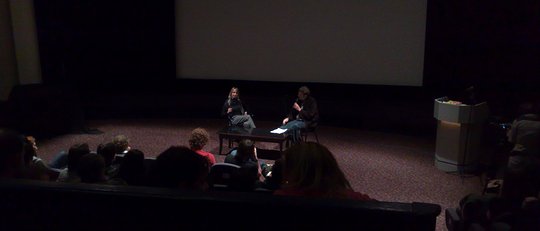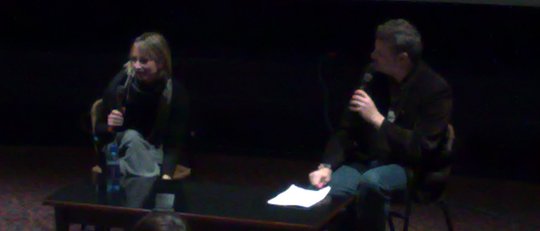 Photo by xahldera and used under the Creative Commons Attribution-Non-Commercial-Share Alike 2.0
Photo by xahldera and used under the Creative Commons Attribution-Non-Commercial-Share Alike 2.0
Taking place in Glasgow in the week leading up to the Glasgow Film Festival, the premiere was preceded by the airing of the first movie in the Rebuild series: Evangelion 1.0. Bookended by an informative talk by Emily Fussell of the BBFC, and an introduction by the effusive Jonathan Clements. Kicking off a series of animated shenanigans dubbed "Scotland Loves Animation" and succeeding the Scottish anime convention "Auchinawa", Scotland and Glasgow in particular is becoming one of the prime places to catch anime and Japanese goings on.
Beginning shortly before half three in the afternoon, tickets had been purchased online for the double bill and sold out in short order. The line for entering the cinema stretched out of the building and it was immediately obvious by the dress of the patrons what they were queuing for. After a short wait and filing into the surprisingly spacious cinema one of the Glasgow Film Theatre, the proceedings were kicked off by Emily Fussell, a media classifier for the BBFC, with a talk focusing on the tribulations in classifying anime for release in the UK.
Either through nerves or disposition, Emily was energetic and her passion for the medium or her role in facilitating its dissemination in Britain was self evident. The main problem, she began, in classifying anime is that often only individual episodes of a wider series are sent through which hinders continuity. The next fives slides highlighted some of the tongue-in-cheek questions this posed:
- Gundam SEED - why are they fighting each other? Aren't they on the same side?
- Undetermined (Negima possibly) - what is a chupacabra?
- Chobits - isn't she a computer?
- Vampire Knight (possibly incorrect) - wait, is he a vampire now or not?
- Kiss x Sis (probably incorrect) - how old are they? Aren't they sisters?
These drew guffaws and applause from the audience. The remainder of the short presentation covered other issues with anime classification, including the situation that while the BBFC may apply age ratings, they have no control over marketing, most aptly highlighted by the cover of the fourth volume of Daphne in the Brilliant Blue which has a content rating of 12A. The mostly knowing audience erupted with laughter at this. After only a few minutes however, the presentation was wrapped up, the lights dimmed, and Evangelion 1.0 begun.
The precise version of the film was 1.01 which was released first on DVD and re-released in theatres in Japan; the most recent 1.11 released in high definition includes a lot more padding scenes which makes the opening less chaotic and gives a lot more texture to the movie and universe. Whether it was the source or the equipment used, the picture quality wasn't stellar and darker scenes suffered from a lack of definition, coupled with a stereo speaker arrangement, the presentation wasn't as arresting as it could have been. Regardless, it was presented in the original Japanese with professional subtitles which picked up on a lot of nuances that amateur and self-translated efforts missed.
 Photo by xahldera and used under the Creative Commons Attribution-Non-Commercial-Share Alike 2.0
Photo by xahldera and used under the Creative Commons Attribution-Non-Commercial-Share Alike 2.0
After the film had wrapped up, Emily took a seat at the front of the auditorium along with Jonathan Clements and began a short talk on how she would classify Evangelion 1.0 into the BBFC's age rating brackets. Surprisingly, it hovers on the borderline between a PG and 12A - this despite the gallons of blood as well as bare female nipples and accidental fondling. The most troubling aspect, she explained, was Shinji's cries for his father when attacked by the sixth angel; the enclosed space and terror would likely raise the rating; the thought occurs that this would be noted down as "mild peril". The issue of blood was more contentious, the argument stands that due to the alien source - the Angels - despite both its colour and viscosity, it wouldn't be counted as blood and thus would likely not affect the rating beyond a PG - this is to say nothing of its rainbow causing properties. The infamous Rei and Shinji scene was further clarified in that despite the situation, there were no overt sexual connotations to the scene, helped by Shinji's obvious confusion after the event. This idea was expanded on in the question and answer section that followed the exchange between Emily and Jonathan.
The questions came from all parts of the audience but were dominated by a group of four to six people whose queries managed to be erudite without being tawdry. Emily's forthrightness with answers was refreshing, especially when it came to which words garnered which classification: "motherfucker" was allowed in a 12A but repeated usage ensured 15, and "cunt" was a guaranteed 18. This was characterised by the most recent adaptation of The Wicker Man with Nicolas Cage which was a 12A horror film upon cinema release but a 15 on DVD with the addition of some cursing; thankfully Emily was just as clear as to the quality of the film as everyone else. Chobits was brought up again, specifically the scene where Chii is powered up with the switch located where her genitals are supposed to be, for that the series was classified as a 15. More topically however, an audience member brought up the problem between canonical age and visual age, referencing Yoko from Gurren Lagann supposedly only being fourteen; according to Emily this isn't a problem when it comes to classification unless the character is involved in something sexual or the disparity in some way encourages underage sex. This was followed by a question as to the pertinence of the Extreme Pornography law that is coming into effect within the UK in April 2010 which makes it illegal to own drawn or illustrated images depicting underage sex rather than how it currently stands which focuses on actual child abuse: this response was met with stoic and mute indifference despite the polarising fervour it has stirred up in other places.
With time wearing on, the session was wrapped up and Jonathan introduced the premier of Evangelion 2.0. Beginning with an overview of the Evangelion franchise from a marketing perspective and referencing Naruto as an example of a cash cow, it was initially implied that the Rebuild movies were little more than attempts by GAINAX to sell more merchandise - the expectation for mention of the recent Evangelion bike shorts and guitars was thankfully not fulfilled. This view however was contextualised with the insight that animators are usually just glad no one notices any faults rather than being content with what is released, making the movies a good way of providing a different, complete take on the series. Jonathan's knowledge of both the anime industry and Evangelion in particular shone through with a wide knowledge of the canon and anecdotes of the production such as how late finished episodes were being delivered to be screened, including an unvetted bed scene with Misato and Kaji that made it on to Japanese prime time television.
The most fascinating part however was information on the much vilified live action adaptation. Jonathan was apparently consulted by AD Vision (now dissolved) on the movie, specifically on how he would approach it. His response was to set it in Germany and then the US with Asuka, only arriving Japan part of the way through the film; next was the question of what he would do were it a trilogy? Use that idea as the second film and make the first about second impact he responded. The idea is tantalising, to be able to see many of the things only hinted at, however with whispers of Jerry Bruckheimer being pitched the concept, the Hollywood filter would surely wring all subtext from it. There was a solitary cheer from the front of the cinema when it was revealed that ADV ran out of money and, for the moment at least, the movie remains in limbo. Wrapping up his fulsome and affirming intro, the premier of Evangelion 2.0 begun.
The visible area of the screen was increased and immediately the difference in both picture and sound quality was tangible. The viewing was almost certainly from a cinema print with the subtitles looking like they had been freshly impressed upon the celluloid. Throughout there was riotous laughter at some of the in-jokes and some inappropriate chortles from several areas of the cinema at some of the more gruesome violence on display. Running uninterrupted for the full two hours, even with Jonathan's prior warning as to the ending, there were whoops and applause when the credits rolled despite the abrupt stop to the climax which had just occurred. Several patrons unwisely departed during the credits and a roar of excited chatter began, completely drowning out the PlanitB remix of Utada Hikaru's Beautiful World. As expected though, when the epilogue begun, the effect on the ambient conversation was immediate; some even begun a clipped second applause as the next movie preview was played. Without a doubt the appreciation was immense and the snippets of conversation caught as the lights raised were all immensely complimentary.
In all the two movie feature was well put together, both guests were fascinating and showed a different side to a too often myopic media and while the presentation of 1.0 was mildly disappointing, the gobsmackingly brilliant 2.0 more than made up for this. Thoroughly enjoyable and hopefully the first of many similar events.
I can see your concerns. On the other hand, the concerns of bringing Government closer to the people and making it more open, especially in the shadow of the expenses scandals, is important. The ideal situation would be a more Federal UK, where each of the home nations have their own assembly/parliament with devolved powers with Westminster being made a Federal Legislature to cover nation things like defence, foreign policy, health and law. But things like local governance would be dealt with by the devolved parliaments and assemblies.
I look forward to more such anime film events here in Scotland. We are really lacking on these sorts of things and need more of them.